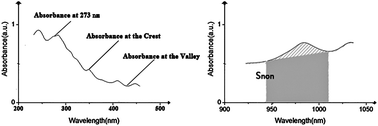The characterization of the concentration of the single-walled carbon nanotubes in aqueous dispersion by UV-Vis-NIR absorption spectroscopy
Abstract
Current and future applications of single-wall

* Corresponding authors
a
School of Materials Science and Engineering, University of Science and Technology Beijing, Beijing 100083, China
E-mail:
zhengyudong@mater.ustb.edu.cn
Fax: +86-10-62330802
Tel: +86-10-62330802
b
National Institute of Metrology, China, Beijing 100013, China
E-mail:
renll@nim.ac.cn
Fax: +86-10-64524991
Tel: +86-10-64524991
c Department of Applied Chemistry, Beijing University of Chemical Technology, Beijing 100029, China
Current and future applications of single-wall

 Please wait while we load your content...
Something went wrong. Try again?
Please wait while we load your content...
Something went wrong. Try again?
B. Yang, L. Ren, L. Li, X. Tao, Y. Shi and Y. Zheng, Analyst, 2013, 138, 6671 DOI: 10.1039/C3AN01129A
To request permission to reproduce material from this article, please go to the Copyright Clearance Center request page.
If you are an author contributing to an RSC publication, you do not need to request permission provided correct acknowledgement is given.
If you are the author of this article, you do not need to request permission to reproduce figures and diagrams provided correct acknowledgement is given. If you want to reproduce the whole article in a third-party publication (excluding your thesis/dissertation for which permission is not required) please go to the Copyright Clearance Center request page.
Read more about how to correctly acknowledge RSC content.
 Fetching data from CrossRef.
Fetching data from CrossRef.
This may take some time to load.
Loading related content
